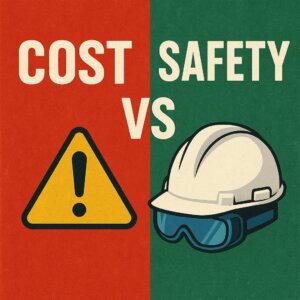When working in the chemical industry, PPE isn’t just a precaution — it’s your last line of defense. But what happens when this defense fails, not because the gear is missing, but because it’s misused? Let’s explore some of the most dangerous PPE mistakes in chemical environments — and how to avoid them.
1. Neglecting Eye and Face Protection
Chemical splashes can cause permanent damage in seconds. Yet, many workers still rely solely on safety glasses or skip them entirely. For tasks involving corrosive or reactive substances, a full-face shield combined with goggles should be the standard — not the exception.
What to do instead:
Ensure all workers are equipped with EN166-compliant eye and face protection and receive training on proper wear and maintenance. Check for fogging or scratches that reduce visibility or protection.
2. Wearing Damaged or Corroded Gloves and Footwear
Chemical-resistant gloves and boots may look fine on the outside, but prolonged exposure to aggressive substances can degrade their materials without obvious signs. Some workers continue using gloves with tiny pinholes or soles that have been eroded by acids — unknowingly exposing themselves to serious harm.
What to do instead:
Implement a routine inspection and replacement program. If gloves or soles show discoloration, stiffness, or softness, it’s time to replace them. Choose materials that match the specific chemicals handled — nitrile, neoprene, butyl rubber, etc.
3. Failing to Replace PPE After a Spill
Chemical splashes don’t just affect skin — they can seep into clothing layers and linger. Workers sometimes continue wearing contaminated PPE thinking it’s “just a small splash.” The risk? Delayed skin burns, long-term health damage, or spreading chemicals to clean areas.
What to do instead:
Any PPE exposed to chemical spills should be replaced immediately. If reuse is necessary, make sure decontamination procedures are clear and strictly followed.
4. Using the Wrong Type of Respirator
Chemical vapors, mists, and gases require different filtration systems. Using a dust mask in a vapor-heavy environment is like locking the front door but leaving the windows wide open.
What to do instead:
Select respirators according to EN136 or EN140 standards. Use proper filter cartridges (e.g., ABEK filters for organic/inorganic gases and acids) and train workers to perform seal checks before every use.
5. Assuming One Suit Fits All
Some workers wear basic cotton coveralls or general PPE in chemical zones — completely unaware that these fabrics can absorb and retain harmful substances, or even melt upon contact with aggressive chemicals.
What to do instead:
Use chemical-resistant suits certified to EN14605 or equivalent. Look for splash-proof or gas-tight models depending on the exposure risk.
Final Thoughts
Chemical PPE isn’t just about ticking a box — it’s about choosing the right protection, at the right time, in the right condition. At CHEAMY, we help safety managers and procurement teams make smart decisions, backed by practical insights and reliable gear.
Remember: PPE misuse is often invisible — until it’s too late. Prevention starts with awareness.








